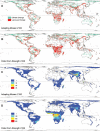Projected impacts of climate and land-use change on the global diversity of birds
- PMID: 17550306
- PMCID: PMC1885834
- DOI: 10.1371/journal.pbio.0050157
Projected impacts of climate and land-use change on the global diversity of birds
Abstract
Over the past few decades, land-use and climate change have led to substantial range contractions and species extinctions. Even more dramatic changes to global land cover are projected for this century. We used the Millennium Ecosystem Assessment scenarios to evaluate the exposure of all 8,750 land bird species to projected land-cover changes due to climate and land-use change. For this first baseline assessment, we assumed stationary geographic ranges that may overestimate actual losses in geographic range. Even under environmentally benign scenarios, at least 400 species are projected to suffer >50% range reductions by the year 2050 (over 900 by the year 2100). Although expected climate change effects at high latitudes are significant, species most at risk are predominantly narrow-ranged and endemic to the tropics, where projected range contractions are driven by anthropogenic land conversions. Most of these species are currently not recognized as imperiled. The causes, magnitude and geographic patterns of potential range loss vary across socioeconomic scenarios, but all scenarios (even the most environmentally benign ones) result in large declines of many species. Whereas climate change will severely affect biodiversity, in the near future, land-use change in tropical countries may lead to yet greater species loss. A vastly expanded reserve network in the tropics, coupled with more ambitious goals to reduce climate change, will be needed to minimize global extinctions.
Conflict of interest statement
Figures



References
-
- Warren MS, Hill JK, Thomas JA, Asher J, Fox R, et al. Rapid responses of British butterflies to opposing forces of climate and habitat change. Nature. 2001;414:65–69. - PubMed
-
- Parmesan C, Yohe G. A globally coherent fingerprint of climate change impacts across natural systems. Nature. 2003;421:37–42. - PubMed
-
- Walther GR, Post E, Convey P, Menzel A, Parmesan C, et al. Ecological responses to recent climate change. Nature. 2002;416:389–395. - PubMed
-
- Root TL, Price JT, Hall KR, Schneider SH, Rosenzweig C, et al. Fingerprints of global warming on wild animals and plants. Nature. 2003;421:57–60. - PubMed
-
- Pimm SL, Raven P. Biodiversity—Extinction by numbers. Nature. 2000;403:843–845. - PubMed
Publication types
MeSH terms
LinkOut - more resources
Full Text Sources
Miscellaneous

